|
|
Chaucer

|
|
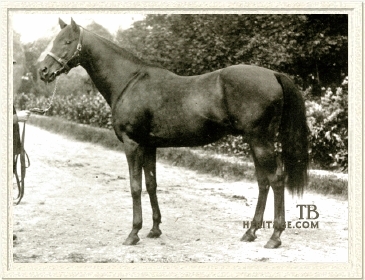 |
|
|
There is a plaque at Woodlands Stud in Newmarket, England, installed by that stud's owner, Lord Derby, that acknowledges the homebred stallion Chaucer as founder of the Derby stud. Chaucer was a good but not great runner, and a good but not great sire, however, he was a truly great broodmare sire whose daughters have produced some of the most important runners and stallions of the Twentieth Century.
|
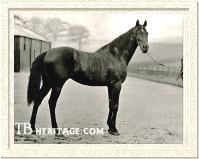
His sire, St. Simon
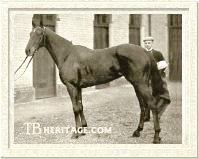
His dam, Canterbury Pilgrim | | Chaucer was a little brown colt foaled in 1900, by St. Simon from the mare Canterbury Pilgrim. St. Simon had already proven himself one of the great runners of the century, and was well into a stud career that established him as one of the most influential sires in the breed.
Bred by Prince Batthany of Hungary and owned by the Duke of Portland, from his home base at Welbeck Abbey Stud, St. Simon sent out a stream of champions and classic winners which included Persimmon, St. Frusquin, La Fleche, William the Third, Mrs. Butterwick, and important sires such as Persimmon, Desmond, St. Frusquin, Rabelais, and Chaucer.
Chaucer's dam, Canterbury Pilgrim, had been bred by the Duchess of Montrose's Sefton Stud and was purchased on behalf of Lord Derby at the 1894 Newmarket July Yearling sales. The filly by the hardy stayer Tristan out of 1,000 Guineas winner Pilgrimage was just one of several important animals to be included in the dispersal of the Duchess's stock that year. Others included Roquebrune (stakes winner and dam of Triple Crown winner Rock Sand), and Pilgrimage herself, carrying the 1898 Derby winner Jeddah. |
|
Canterbury Pilgrim showed speed but no staying power at two. She bloomed over the winter in training that pointed her for the Oaks. She won that classic, and also tallied the Park Hill Stakes, Liverpool Summer Cup, and Jockey Club Cup before she was retired. A tiny mare with a wicked temper, she passed on many of her best and worst qualities to her foals.
Chaucer was Canterbury Pilgrim's second foal from a brood of ten, which included a few merely useful broodmare daughters but two vastly important sons, Chaucer and his younger half-brother Swynford (foaled in 1907). Like his dam, Chaucer was a very small horse, maturing at just 15.1 1/2 hands, although when he went into training, he barely reached 15 hands. He was built similarly to his dam, being short and low in the withers, but his sire St. Simon passed along refinement and elegance, giving the little colt tremendous quality overall. Both parents had been particularly excitable in training, which in Chaucer, translated more into nervousness and stubbornness than the dangerous displays enacted by his notorious dam. And although not a classic-level performer, no one questioned his fighting spirit.
Chaucer on the Turf
Chaucer went into training at Stanley House Stables (built on the grounds of the former Sefton Stud) in Newmarket under the tutelage of the great George Lambton, which Lord Derby had hired when he began his rebuilding of the ancient Derby racing stud and stables in 1893. From five starts at two, Chaucer was never worse than third, winning twice, second twice and once third.
Chaucer was second in his debut at Sandown Park in mid-June. The winner was an unnamed colt by Melton, with the good filly Hammerkop (later dam of Derby winner Spion Kop) finishing in the rear. At the end of July Chaucer was third in the Rous Memorial Stakes at Goodwood behind Tippler and Flotsam III. Chaucer broke his maiden in his third start in late August in the Gimcrack Stakes at York, although he was carrying 119 pounds to the second place horse's, Sermon's, 133, with Ladies' Mile in third. He made it two in a row in the Boscawen Stakes at Newmarket in early October, beating Persistence and Saltpetre. His final start of the year came two weeks later when Sermon got his revenge, this time at level weights (131) winning the Prendergast Stakes by four lengths, with Countermark third.
Chaucer's three-year-old season was sabotaged by an epidemic of pink eye that plagued Stanley House that year. He made only four starts, three before the infection was discovered. In his season debut, he ran a very creditable fourth in the 2,000 Guineas, beaten by Rock Sand (on his way to a Triple Crown, with later victories in the Derby and St. Leger), Flotsam III, and Rabelais. He then ran two very poor races in June, unplaced in both the Duchess of York Plate (12 furlongs, Hurst Park), and Royal Hunt Cup (Royal Ascot), before the illness showed symptoms beyond poor performance. In his final start of the season, he ran another poor race in the Molesey Park Autumn Handicap (Hurst Park).
Although he'd shown promise at two and as a spring three-year-old, as an older horse Chaucer was at best a useful but inconsistent handicapper. At four, he started ten times, but won only three of them. He debuted in May with a second in the Stewards' Handicap (6f. Kempton) behind Bachelor's Fancy. Next time out, he ran poorly in the Alexandra Handicap (Gatwick), and returned another uninspired effort in the Wokingham Stakes (6f. Ascot).
Stepped down in class, Chaucer won his first race of the season in late June sprinting in the Soham Plate (Newmarket), and moved up a month later to a mile to win the Sefton Plate (Liverpool). Poor efforts were lodged in his next three starts, the Harewood Handicap (York), Cleveland Handicap (Doncaster), and Haughton Handicap (Newmarket). In November, Chaucer showed some class in winning the Stewards' Plate (Liverpool), although in receipt of nine pounds from Salute in second place, with Western third. Then he rounded out the season with another bad run, unplaced in the Chaddesden Plate (Derby).
At five, Chaucer made eleven starts, and won just twice, but he also ran second three times and third twice, so it was an improvement over the previous season. He returned to the races with a third in the Earl of Sefton's Plate (Liverpool), in a blanket finish which found St. Brendan the winner by a neck over Otherwise, a neck ahead of Chaucer. Chaucer was then second in the Crawfurd Stakes (Newmarket). In late May, he scored in the Doncaster Spring Handicap, with Andria second and Ancaster third. He followed this up note with a disappointing effort running unplaced in the Royal Hunt Cup at Ascot.
Only two horses went postward in the Rous Memorial Stakes (a little over seven furlongs, Ascot) that year, and Chaucer finished second and last behind Hackler's Pride. In the Liverpool Cup (1 3/8 miles, Liverpool), he returned to the winner's circle, defeating Song Thrush and Andover. Two more beaten efforts in the Drayton Handicap (Goodwood) and Peveril of the Peak Plate (Derby). Next out, Chaucer finished third in the Heath Stakes (Newmarket) to Gaspard and Coxcomb. In his final start of the year, Chaucer was second in the Liverpool Autumn Cup to St. Wulfran.
In his final season of racing, Chaucer ran just five times, won only once, and was twice third. Unplaced in the City and Suburban Handicap (Epsom) on his season debut, he won his second Liverpool Cup (1 3/8 miles) carrying 115 pounds, beating Velocity (126) by a neck, with Dinneford (122) in third. Chaucer was then third in the Chesterfield Cup, behind Gold Riach and Velocity. In the Rotschild Plate, he was third of three startes, behind Ypsilanti and St. Wulfran. In the Great Yorkshire Handicap (Doncaster), he was fourth. Pointed for the Liverpool Autumn Cup, he bowed a tendon in training and was retired. His record at this point read 35 starts, eight wins, six seconds, five thirds. In "Names in Pedigrees," Palmer notes that Chaucer was then "shipped to Knowsley in a furniture van."
Chaucer in the Stud
Chaucer stood his first season at stud at Knowsley in 1907, and was moved to Woodland Stud in Newmarket for 1908, which is where he remained for the rest of his life. As a stallion, Chaucer far exceeded himself as a racehorse. Although never topping the sires list, he was second in 1916 (after Polymelus) and fourth in 1918. His fillies were generally better than his colts with one notable exception (Stedfast), illustrated by the fact that his two classic winners were the 1,000 Guineas winners Pillion and Canyon. Like so many "filly sires," Chaucer became a tremendous broodmare sire, in fact one of the best of all time. He led the broodmare sires list twice, in 1927 and 1933.
His first crop, foals of 1908, included his best son, STEDFAST (1908 out of Be Sure by Surefoot). Although he inherited his sire's tremendous quality and the St. Simon excitability, he was unlike either in color, being a dark chestnut with distinctive grey hairs throughout his coat. Ulbrich notes that he was "a trifle back at the knees, but this did not impair his superb racing action." Bred by Lord Derby, Stedfast won 22 races from 29 starts. At two, he won the Prendergast Stakes and three other races. At three, Stedfast won the Prince of Wales, St. James's Palace, Atlantic, Sussex, Great Yorkshire, Doncaster (in a walkover), Jockey Club, and Kingsclere Stakes , in the latter defeating the famous Prince Palatine. His only losses that year were a second in the 2,000 Guineas and Derby (both to Sunstar), and in the Union Jack Stakes. At four and five, Stedfast's victories included the Coronation Cup, Hardwicke Stakes, Champion Stakes, Newmarket Cup, a second Atlantic Stakes, and walkovers in the Rothschild Stakes (at four) and The Whip (at five). At one point, he carried a twelve-race winning streak, beginning with the Prince of Wales Stakes at three and ending with the Hardwicke Stakes at four. |
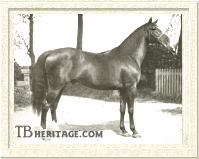
Stedfast
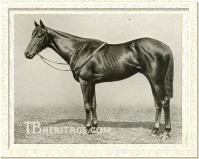
Prince Chimay
| |
At stud, Stedfast sired the Oaks winner Brownhylda (later dam of the St. Leger winner and French sire Firdaussi), and The Night Patrol, a stakes winner in England, and winner of the Cox Plate in Australia. Stedfast's blood found more of an outlet in Australia and New Zealand. The Night Patrol was a sire in Australia,and his son Powerscourt sired the important mare Wee Cushla. Another son, Musketoon sired some useful offspring in New Zealand. Stedfast's daughter Constant Lady produced Constant Son, a good sire in Australia.
Chaucer's other good colt was PRINCE CHIMAY (1915 out of Gallorette by Gallinule), another chestnut like Stedfast, and a good horse but nowhere near the caliber of his Manton stablemate, Gainsborough. At minor stakes winner at two, Prince Chimay had his best year at three, highlighted by a victory in the Jockey Club Stakes (1 3/4 miles), scoring an upset over the mighty Gainsborough. He also won the Windsor Stakes and Silverley Handicap, both at twelve furlongs, and was second in the Jockey Club Cup, to Queen's Square (also by Chaucer), and third in the September Stakes to Gainsborough and My Dear.
Prince Chimay stood one season at stud in England than was sold to France, where he was relatively ineffective outside of siring Poule d'Essai des Poulains (French 2,000 Guineas) winner Vatout. The latter was quite a successful sire in France, getting Derby winner Bois Roussel, leading French sire Vatellor, Atout Maitre, and others. |
Chaucer's other good sons included DANSELLON (1914 out of Tortor by Volodyovski), Craven Stakes, second Derby Stakes; LORD CHAUCER (1924 out of Sabotiere by Minoru), from one of his sire's last crops, imported to race in America and winner of the important Hopeful Stakes at Saratoga in 1926; DAN RUSSELL (1911 out of Hettie Sorrel) winner of the Chester Vase, Knowsley Dinner Stakes, Home-Bred 3YO Stakes, and Triennial Produce Stakes; RATTLIN' THE REEFER (1926 out of Reef by Rochester), Richmond Stakes at two; DONNITHORNE (1909 out of Hettie Sorrel), Manchester Cup; and DONZELON (1921 out of Tortor by Volodyovski), Liverpool Autumn Cup. Outside of Stedfast and Prince Chimay, none of these other sons left a mark as a sire.
Chaucer's best runner, however, was the Derby-bred filly SELENE (1919 out of Serenissima by Minoru). Like most of this bloodline descending from Canterbury Pilgrim, she was very small and in her case, the condition was remarkable enough that she was not nominated for the classics. This proved a serious mistake, because Selene was by far the best filly of her crop, and possibly the best of her age of either sex. At two she won eight of eleven races including the filly championship, the Cheveley Park Stakes, Rous Memorial and Houghton Stakes. At three, she also won eight of her eleven starts including the Park Hill Stakes, Liverpool Autumn Cup, Hampton Court Great 3YO Stakes, and Nassau Stakes. |
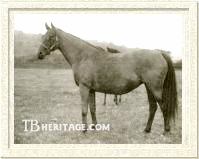
Selene
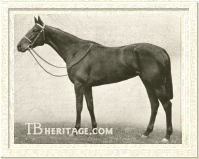
Canyon
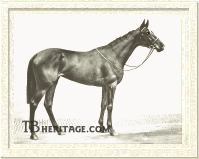
Pillion
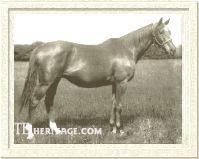
Scapa Flow
| |
As a broodmare, Selene proved a phenomenon. She produced 15 foals, including the great champion and leading sire Hyperion, also the classy Sickle (one of the best at two and three, and the Leading Sire in the U.S. in 1936 and 1938), Pharamond II (Middle Park Stakes at 2, among the leading sires in the U.S.), Hunter's Moon (Newmarket Stakes; a leading sire in Argentina), Night Shift, Guiscard, the sires Moonlight Run and Salamis, and broodmares All Moonshine (dam of Mossborough; ancestress of Sir Tristram), Coronal, Moon Priestess, and New Moon.
Chaucer's classic-winning homebred daughter CANYON (1913 out of Glasalt by Isinglass) won four of ten starts including the Bretby and Bedford Stakes at two. At three, her only major run was in winning the 1,000 Guineas, in which she beat Fifnella, who went on to win the Derby (with Canyon sixth). Canyon made up for this disappointing season by becoming one of the best broodmares in the Derby stud. Among her seven winners were the colts Colorado (2,000 Guineas victor in 1926, the best older horse in training at four, and a major loss as a stallion, dying after siring two very successful foal crops), Caerleon (Eclipse Stakes at four), and Halcyon (Richmond Stakes at two).
Chaucer's other classic filly, PILLION (1923 out of Double Back by Bachelor's Double), was placed in the Cheveley Park Stakes, Houghton Stakes, and Rous Memorial at two. At three, she won the 1,000 Guineas and the Nottinghamshire Steward's Handicap, but did little else. As a broodmare, she was disappointing, although her daughter Pilch produced Doncaster Cup winner Aldborough.
Lord Derby's filly SCAPA FLOW (1914 out of Anchora by Love Wisely) won the Scarborough Handicap but was not a classy runner otherwise. As a broodmare, however, she produced three very high class runners and two epoch-making sires. Fairway was the champion of his crop, and won the St. Leger Stakes in 1928, going on to become the Leading Sire in England four times (1936, 1939, 1943, 1944). Fairway's son Fair Trial also led as a sire, as did Fair Trial's sons Court Martial and Petition.
Fairway's older brother Pharos was an entirely different sort of horse, but still of high class, winner of the Champion Stakes. At stud, Pharos was a great sire, the Leading Sire in 1931, and his son Nearco was the Leading Sire twice more. Pharos and Fairway's younger sister Fair Isle won the 1,000 Guineas in 1930. Their siblings Spithead, Fara and Highlander were also stakes winners.
|
Chaucer's other good racing daughters included QUEEN'S SQUARE (1915 out of Chere Reine by Florizel II), winner of the Newmarket Oaks, Jockey Club Cup (beating Prince Chimay), and Goodwood Cup; DANIELLA (1917 out of Lady Dan by Cornstalk), Ellesmere Handicap; NICEST (1924 out of Nice by Minoru), and SAUCER (1920 out of Tennyson by Wuffy).
Besides those already mentioned, Chaucer's producing daughters included LADY NAIRNE (dam of 2,000 Guineas winner Colombo), APRILLE (dam of Apron), MARY MONA (dam of Warden of the Marches), POET'S STAR (dam of Priok, Pervencheres, Ponteba), MELLOWNESS (dam of Meadow Rhu), and VERSATILE (dam of Starweed).
Besides leading Chaucer to two broodmare sire championships, his daughters forged a tremendous nick with another bloodline in the Derby stud which was to change the face of racing. Derby had bred the stallion Phalaris and stood him at Woodlands. Although a sprinter himself, when crossed on daughters of the stoutly-bred Chaucer, he sired Fairway, Pharos, Sickle, Pharamond II, Colorado, Caerleon, Halcyon, Warden of the Marches, Fair Isle, Fara, Starweed, and Meadow Rhu. The first four named represent the four most prominent male lines in the breed today, evidence of a remarkable collaboration.
In his 26th year, Chaucer suffered "a paralytic seizure" and was mercifully destroyed on February 4, 1926. Lord Derby had a plaque placed at Woodland Stud in his honor, acknowledging him as the founder of the modern Derby stud.
--Anne Peters |
|
|
|

